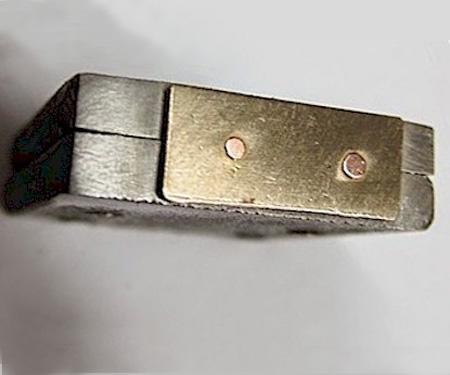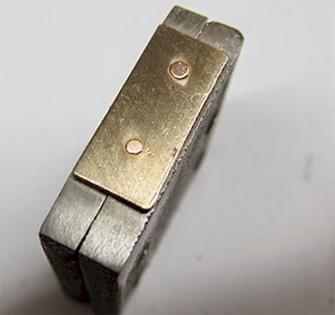Online Jewelry Training Classes for Metalsmiths



Often, when I am busy on a project, I have a need to rivet something in place in an area that does not allow me to drill right through to peen the rivet over on both sides.
The other options are to make tiny screws and tap a hole, but when this comes down to 1mm taps, it gets very wearisome very quickly.
Another option is to solder the object in place, but often that is not easy or even possible, depending on how finished the object is.
Also just putting a pin in the hole and hammering it down does not work well at all.
What I wanted was a rawl-type plug that would expand at the bottom like a masonry
bolt which would cold connect the metals.
The problem is I never know what ACTUALLY happens at the bottom.
So I made two flat pieces of plate and tapped the one side and screwed them together.
Then I drilled a 1mm hole down the seam.
Now I could split them apart to see what happened.

I drew down some wire from 2.5mm to 1mm without annealing.
That made it semi hard, so when it gets tapped down, it would not collapse on itself.
I used a fine three corner file to file a notch into the wire at the bottom, making sure it would collapse there.

After I had drilled the 1mm hole about 4mm deep, I used a 1mm setting burr to create a cavity at the bottom of the hole.

I used copper and silver but of course one could just as easily use gold.
The picture shows the collapse of the bottom of the rivet into the cavity.

So then I used dead-end riveted and applied the piece of brass to the two plates as if I were doing a real job.

When the two plates were split, it revealed that the rivets had collapsed nicely.

The holes in the bottom are previous endeavors.

Prying the plate off proved satisfyingly difficult.
One can clearly see how the rivet tops deformed before the bottom let go.
While this method will probably not be good for critical components, it will work perfectly well small objects like the plate shown.

Some further questions answered:
Noel asked whether a straight rivet without a notch filed in would also work – nope, it does not seem to collapse enough.
Another question was whether the holes had to be deep.
2.5mm works well.

And finally, how does one make the cavity in the bottom?
So I put the burr in the hole by way of explanation.
Very easy.

Practical application in projects:
So while I was working on my dragon, I decided to use this method to do some copper overlay work.
Then I made a mistake, the piece was positioned incorrectly and also much to far away from the crest.
So this was a perfect opportunity to pull the rivets out and see how they actually hold in real life, not with a test piece.

The first one pulled out, but with much difficulty.
As can be seen, the copper overlay was very distorted.

Here is a close up of the rivet.
As one can see, the notch that I filed in the rivet did not collapse completely, so that was why I could still pull it out.

The second one did not pull out and the overlay metal tore open.
I had to in fact drill it out, there was no way I could pull it out with pliers.
I assume the the notch did collapse completely in this one.

Here is a picture of the dragon neck with the one rivet out and the other still in.
I am very happy with this method.
This dead-end rivet method can be used in various jewelry applications where a cold connection is called for like when having to join other metals to titanium.
or select other projects from Jewelry Making Tutorials List
If you have any questions or wish to be notified of any new tutorials that are posted, email me.
This content is the intellectual property of Hans Meevis. More information on our Copyright and Privacy Policy